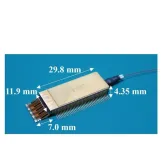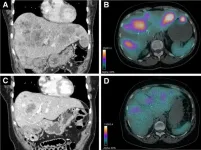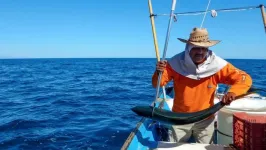(Press-News.org) This study included larger groups of people from African, Hispanic and Asian ancestries than many other previous studies.
A recent study involving scientists from the U.S. Department of Energy’s (DOE) Argonne National Laboratory has uncovered insights into the prostate cancer risks of people from a variety of genetic ancestries. The project, which was led by the University of Southern California, included large increases in representation among men of African, Hispanic and Asian ancestries, that were contributed in part by an ongoing collaboration between the U.S. Department of Veterans Affairs (VA) and DOE as part of the Million Veteran Program Computational Health Analytics for Medical Precision to Improve Outcomes Now (MVP-CHAMPION) project.
Ravi Madduri, an Argonne researcher who is a senior author on the project, spoke during an interview about the paper about the limitations of previous studies.
“There have been a lot of studies to understand the relationship between the risk for prostate cancer and the genetic makeup of a particular individual,” Madduri said. “Most of the studies have been done in the context of people who are of European ancestry, and very little is known in terms of the contribution of genetic ancestry of other peoples to their risk for prostate cancer.”
While simply focusing on different ancestries made this project stand out, the truly unique factor of this research was the data provided by the MVP. The MVP is one of the largest and most diverse collections of genetic information in the world, with one million veterans joining since the program’s launch in 2011. The study of this genetic data was performed using the latest techniques in high performance computing (HPC) and artificial intelligence (AI), and this unprecedented biobank enabled researchers to reach further than any that came before it.
Studying populations
Prostate cancer is the most frequently diagnosed non-skin cancer globally, and as such, it is a problem that affects the entire human population. To understand the likelihood of an individual or population developing prostate cancer, researchers create what is known as a Genetic Risk Score (GRS). This is an estimate of the cumulative contribution of genetic factors to a specific health outcome.
“You look at the genetic sequence and compare the variants that you find in the genetic sequence to the variants that are already found that have an impact on the particular disease,” Madduri said. “And then you calculate the risk for that particular person.”
Specifically, the research group focused on single nucleotide polymorphisms (SNPs.) These are variations at a single position in a DNA sequence that act as biological markers that help scientists locate genes that are associated with disease.
For this study of 156,319 prostate cancer cases and 788,443 control cases, the GRS is calibrated by adding up all the risks contributed by individual SNPs. Here, the researchers found 187 new genetic markers that provide more accuracy in calculating the risk posed by a particular ancestry. This increased the total number of known risk variants to 451.
Madduri stated that his background as a computing scientist has him working in various domains applying HPC to accelerate scientific discovery. Work like this performed with the giant MVP database is ripe for HPC optimization, as the scientists need to look at each genetic sequence and compare any discovered variants with previously discovered variants to determine if they will have an impact on a particular disease.
“The current algorithms that are typically used for this process can run about a thousand individuals at a time, and they are kind of slow,” Madduri said. “They are not created or designed to run on hundreds and thousands of participants in parallel together. So, Alex Rodriguez and I have created a high-performance pipeline that calculates the risk variance for all of the participants in the cohort in a very short amount of time.” Alex Rodriguez is a computer scientist at the University of Chicago collaborating on this project.
Different ancestries, different risks
As Madduri pointed out, this work was centered around a desire to understand the genetic makeup that increases risks for diseases like prostate cancer. Of course, genetic architecture is heavily based on a person’s ancestry, and previous studies did not include people who do not share a European ancestry.
This is especially true of people with African ancestry. In this study, the case sample size was increased by 43% for people of European ancestry over previous studies, 26% for those with Asian ancestry, 45% for Hispanic groups and a whopping 87% for those with African ancestry.
This inclusive approach enabled unique discoveries. For instance, in terms of the GRS for the current 451 risk variants, men of African ancestry showed a greater risk of aggressive versus non-aggressive disease.
This increase of representation is obviously important for groups that are often marginalized and forgotten, but it also helps people outside of these groups.
“This study not only provides more insight into the genetic architecture of people with African ancestry, but it also provides a large population that helps validate genetic findings from other populations,” Madduri said.
Science involving such a large database like MVP can sometimes feel impersonal, as the individual can often be lost in such a large group. But for researchers like Madduri, the contributions of every person involved is of the utmost importance — not only for what they contribute to science with their data, but also in terms of what they’ve provided for their country.
“Prostate cancer is the second-biggest killer of our nation’s veterans,” Madduri said. “For the people who have given everything for our country, it is our duty to help them when they need it.”
Argonne National Laboratory seeks solutions to pressing national problems in science and technology. The nation’s first national laboratory, Argonne conducts leading-edge basic and applied scientific research in virtually every scientific discipline. Argonne researchers work closely with researchers from hundreds of companies, universities, and federal, state and municipal agencies to help them solve their specific problems, advance America’s scientific leadership and prepare the nation for a better future. With employees from more than 60 nations, Argonne is managed by UChicago Argonne, LLC for the U.S. Department of Energy’s Office of Science.
The U.S. Department of Energy’s Office of Science is the single largest supporter of basic research in the physical sciences in the United States and is working to address some of the most pressing challenges of our time. For more information, visit https://energy.gov/science.
END
Uncovering insights about prostate cancer risk and genetic ancestry
A new study from Argonne is shedding new light on how ancestry plays a role in prostate cancer risk
2024-02-13
ELSE PRESS RELEASES FROM THIS DATE:
A century of reforestation helped keep the eastern US cool
2024-02-13
American Geophysical Union
13 February 2024
AGU Release No. 24-5
For Immediate Release
This press release and accompanying multimedia are available online at: https://news.agu.org/press-release/a-century-of-reforestation-helped-keep-the-eastern-us-cool/
A century of reforestation helped keep the eastern US cool
Much of the U.S. warmed during the 20th century, but the eastern part of the country remained mysteriously cool. The recovery of forests could explain why
AGU press contact:
Liza Lester, +1 (202) 777-7494, news@agu.org (UTC-5 hours)
Contact information for the researchers:
Kim ...
IL-17 promotes IL-18 production in osteoarthritis synovial fibroblasts via…
2024-02-13
“This study provides novel insights into the pathogenesis of OA and suggests a potential therapeutic target in OA treatment.”
BUFFALO, NY- February 13, 2024 – A new research paper was published in Aging (listed by MEDLINE/PubMed as "Aging (Albany NY)" and "Aging-US" by Web of Science) Volume 16, Issue 2, entitled, “IL-17 promotes IL-18 production via the MEK/ERK/miR-4492 axis in osteoarthritis synovial fibroblasts.”
The concept of osteoarthritis (OA) as a low-grade inflammatory ...
New data speed record on optical fiber
2024-02-13
As data traffic continues to increase, there is a critical need for miniaturized optical transmitters and receivers that operate with high-order multi-level modulation formats and faster data transmission rates. In an important step toward fulfilling this requirement, researchers developed a new compact indium phosphide (InP)-based coherent driver modulator (CDM) and showed that it can achieve a record high baud rate and transmission capacity per wavelength compared to other CDMs. CDMs are optical transmitters used in optical communication systems that can put information on light by modulating the amplitude and phase before it is transmitted through optical fiber.
“Services that require ...
UBCO researchers get to the bottom of non-invasive gut tests
2024-02-13
New research from UBC Okanagan could make monitoring gut health easier and less painful by tapping into a common—yet often overlooked—source of information: the mucus in our digestive system that eventually becomes part of fecal matter.
Correct, what’s in our poop.
Researcher Dr. Kirk Bergstrom and post-graduate student Noah Fancy of UBCO's Biology department discovered a non-invasive technique to study MUC2, a critical gut protein, from what we leave behind in the bathroom.
“MUC2 is like the silent star in our guts. It’s constantly working ...
Radiopharmaceutical therapy controls symptoms and reduces medications in insulinoma patients
2024-02-13
Reston, VA—Peptide receptor radionuclide therapy (PRRT) is effective for clinical control of symptomatic metastatic insulinomas, according to new research published in the February issue of The Journal of Nuclear Medicine. In the largest study to date of metastatic insulinoma patients treated with PRRT, more than 80 percent of patients had long-lasting symptom control, and nearly 60 percent were able to reduce the use of other drugs to treat the disease.
Metastatic insulinoma is a rare malignant neuroendocrine tumor characterized ...
First-of-its-kind ACC registry tracks cardiac procedures performed in ambulatory surgical settings
2024-02-13
The American College of Cardiology’s newest registry offers data-driven insights on cardiac procedures performed in the ambulatory surgery setting through its first-of-its-kind dashboard. The number of cardiac procedures being performed in ambulatory surgery centers has grown significantly in the last decade, leading ACC’s NCDR to create the CV ASC Registry Suite to fit into the established workflow and allow these facilities to measure and compare their patient care and outcomes to similar procedures performed in the hospital outpatient setting.
Ambulatory surgery centers (ASCs) are health care facilities that provide same-day surgical care, ...
Business operations affect fishermen's resilience to climate change, new study finds
2024-02-13
Timothy Frawley has spent the better of the past two decades working in and around commercial fisheries. Born and raised in Casco Bay, Maine, he grew up packing lobsters and pitching bait on Portland’s working waterfront. He has worked in commercial fisheries in California, Alaska and the Mexican state of Baja California Sur.
Throughout his years spent on working waterfronts, Frawley, a postdoctoral researcher affiliated with the University of Maine’s Darling Marine Center, closely observed the ways in which fishermen conducted their business, making decisions about what and how they fished, and how it affected their operations and profit.
“While ...
Not too late to repair: gene therapy improves advanced heart failure in animal model
2024-02-13
Heart failure remains the leading cause of mortality in the U.S. During a heart attack blood stops flowing into the heart. Without oxygen, part of the heart muscle dies. The heart muscle does not regenerate, instead it replaces dead tissue with a scar made of cells called fibroblasts that do not help the heart pump. If there is too much scarring, the heart progressively enlarges, or dilates, weakens and eventually stops working.
“The current thought is that advanced or chronic heart failure, a stage in which the cardiac muscle has become too weak, is a point of no return. The present ...
Seeking a middle ground for reducing greenhouse emissions
2024-02-13
As the world gradually transitions to making meaningful reductions in greenhouse gas emissions, one of the most crucial questions that needs to be answered is how much that change is going to cost.
The United Nations Intergovernmental Panel on Climate Change (IPCC) has put out reports on this potential cost that showed global greenhouse gas emissions can be reduced by at least half in 2030 at a cost of less than $100 per ton of CO2 equivalent. A new study from the University of Delaware, Yale University and Columbia University, however, points out that these estimates do not consider some hidden, underlying frictions ...
New study finds no significant association between preterm delivery and autism
2024-02-13
UNDER EMBARGO UNTIL: Feb. 13, 2024, 3:00 PM EST
Media Contacts: Karen Addis, APR, karen@addispr.com, +1 (301) 787-2394; Kerri Wade, MPA, kwade@smfm.org, +1 (202) 236-1780
National Harbor, Md. -- Autism, also known as Autism Spectrum Disorder (ASD), is one of the most common developmental disorders and is increasingly diagnosed worldwide. According to the World Health Organization, an estimated one in 100 children has autism. In the U.S., those numbers are much higher, with an estimated one in 36 children being diagnosed with autism, according to the Centers for Disease Control and Prevention. Research into the causes of autism, specifically whether there is ...
LAST 30 PRESS RELEASES:
Injectable breast ‘implant’ offers alternative to traditional surgeries
Neuroscientists devise formulas to measure multilingualism
New prostate cancer trial seeks to reduce toxicity without sacrificing efficacy
Geometry shapes life
A CRISPR screen reveals many previously unrecognized genes required for brain development and a new neurodevelopmental disorder
Hot flush treatment has anti-breast cancer activity, study finds
Securing AI systems against growing cybersecurity threats
Longest observation of an active solar region
Why nail-biting, procrastination and other self-sabotaging behaviors are rooted in survival instincts
Regional variations in mechanical properties of porcine leptomeninges
Artificial empathy in therapy and healthcare: advancements in interpersonal interaction technologies
Why some brains switch gears more efficiently than others
UVA’s Jundong Li wins ICDM’S 2025 Tao Li Award for data mining, machine learning
UVA’s low-power, high-performance computer power player Mircea Stan earns National Academy of Inventors fellowship
Not playing by the rules: USU researcher explores filamentous algae dynamics in rivers
Do our body clocks influence our risk of dementia?
Anthropologists offer new evidence of bipedalism in long-debated fossil discovery
Safer receipt paper from wood
Dosage-sensitive genes suggest no whole-genome duplications in ancestral angiosperm
First ancient human herpesvirus genomes document their deep history with humans
Why Some Bacteria Survive Antibiotics and How to Stop Them - New study reveals that bacteria can survive antibiotic treatment through two fundamentally different “shutdown modes”
UCLA study links scar healing to dangerous placenta condition
CHANGE-seq-BE finds off-target changes in the genome from base editors
The Journal of Nuclear Medicine Ahead-of-Print Tip Sheet: January 2, 2026
Delayed or absent first dose of measles, mumps, and rubella vaccination
Trends in US preterm birth rates by household income and race and ethnicity
Study identifies potential biomarker linked to progression and brain inflammation in multiple sclerosis
Many mothers in Norway do not show up for postnatal check-ups
Researchers want to find out why quick clay is so unstable
Superradiant spins show teamwork at the quantum scale
[Press-News.org] Uncovering insights about prostate cancer risk and genetic ancestryA new study from Argonne is shedding new light on how ancestry plays a role in prostate cancer risk



